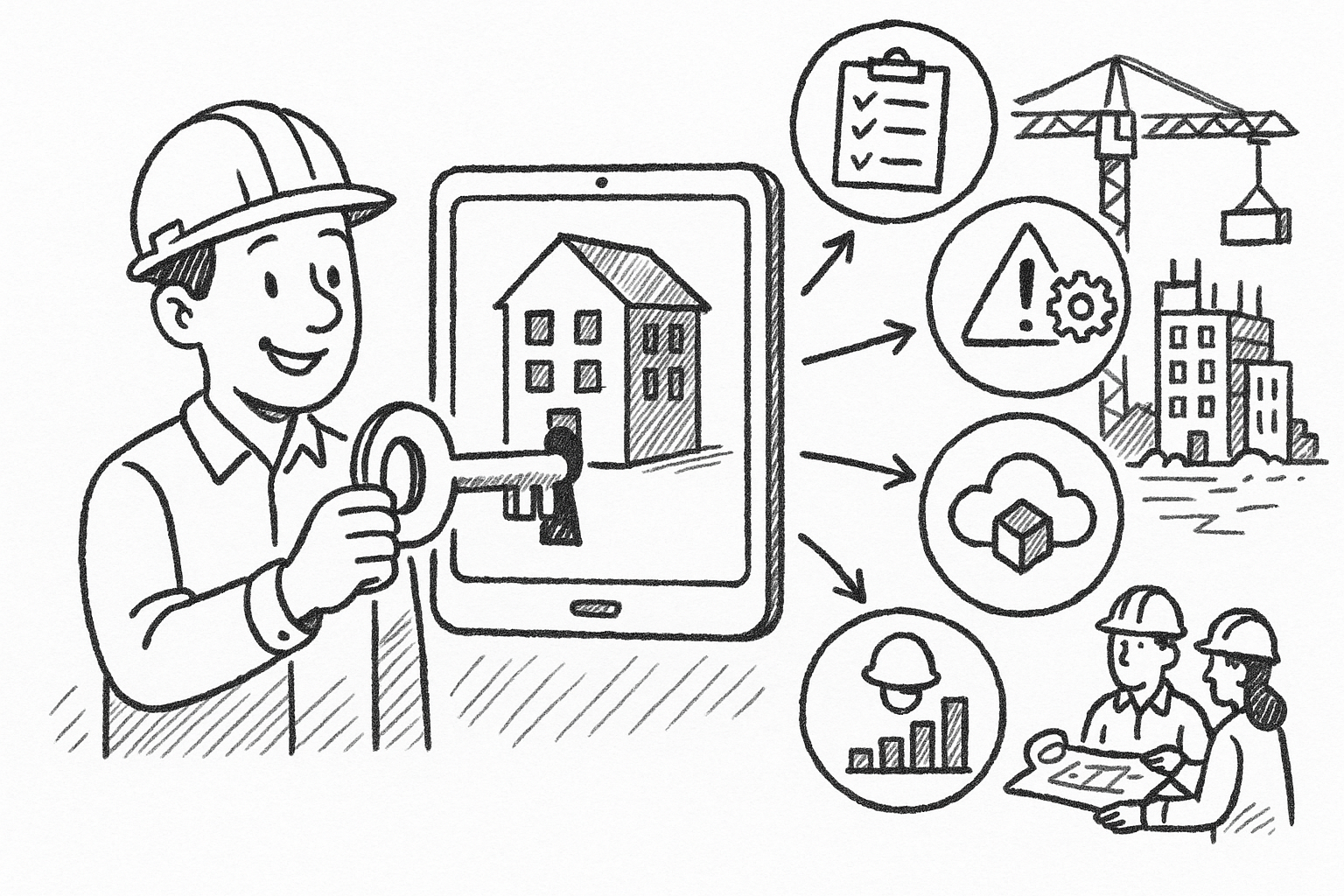Your Cart is Empty
Customer Testimonials
-
"Great customer service. The folks at Novedge were super helpful in navigating a somewhat complicated order including software upgrades and serial numbers in various stages of inactivity. They were friendly and helpful throughout the process.."
Ruben Ruckmark
"Quick & very helpful. We have been using Novedge for years and are very happy with their quick service when we need to make a purchase and excellent support resolving any issues."
Will Woodson
"Scott is the best. He reminds me about subscriptions dates, guides me in the correct direction for updates. He always responds promptly to me. He is literally the reason I continue to work with Novedge and will do so in the future."
Edward Mchugh
"Calvin Lok is “the man”. After my purchase of Sketchup 2021, he called me and provided step-by-step instructions to ease me through difficulties I was having with the setup of my new software."
Mike Borzage
Unlocking Efficiency: 5 BIM 360 Modules Transforming AEC Project Delivery
July 05, 2025 4 min read


Introduction
The Architecture, Engineering, and Construction industry is stepping away from on-premise servers, disconnected spreadsheets, and email-heavy coordination. Cloud-centric delivery has become the new normal, enabling dispersed project teams to transact information in real time while preserving an auditable record of every decision. Autodesk’s BIM 360 platform is at the center of this transformation, intertwining design data, field observations, and cost intelligence on a single backbone. The following discussion explores how five purpose-built BIM 360 modules—Docs, Design Collaboration, Coordinate, Build, and Cost—are delivering measurable gains in schedule certainty, cost containment, safety performance, and collaborative transparency.
BIM 360 Docs – Single Source of Truth for Project Information
Core Functions
Docs acts as the digital master file room, maintaining all 2D sheets, 3D models, specifications, RFIs, and submittals in one permission-controlled location. Automated versioning ensures that the most recent drawing is always on top while preserving a complete revision history for dispute avoidance. Built-in optical character recognition enables granular searching—users can type a valve tag, a room number, or a specification paragraph and immediately locate the corresponding sheet or model view.
Transformational Benefits
- By synchronizing desktop, mobile, and kiosk access, Docs eliminates dangerous “data silos”, ensuring that the superintendent on the 19th floor and the drafter in a different time zone reference the same information.
- Live hyperlinking between sheets and models dramatically speeds up navigation, and visual change indicators cut rework by up to 50 % because clashes are caught before reaching the field.
Implementation Guidance
- Adopt folder naming standards based on ISO 19650 so downstream consultants can predict where any deliverable lives.
- Configure review and approval workflows to mirror existing QA/QC gates, preserving familiar sign-offs while moving the stamp process into the cloud.
BIM 360 Design Collaboration – Real-Time Multidisciplinary Co-Authoring
Core Functions
Leveraging cloud worksharing, Design Collaboration allows architects, structural engineers, MEP designers, and civil teams to author Revit, Civil 3D, and Plant 3D models concurrently. Instead of emailing Navisworks NWDs, each discipline “packages” its updates and pushes them to a timeline view where partners can explore changes before consuming them into their own working sets.
Transformational Benefits
- Simultaneous editing shrinks design iteration cycles from days to minutes, enabling rapid what-if analyses during value engineering sessions.
- Color-coded model histories improve design intent clarity; stakeholders can scrub through time and immediately see how envelope adjustments affect structural grids or MEP routing.
Implementation Guidance
- Define publish rules—weekly, milestone-based, or after a specific task completion—to curb “model noise” that overwhelms collaborators.
- Introduce color-coded clash spheres during design review so team members understand not only where a conflict exists but also its severity before formal coordination meetings.
BIM 360 Coordinate – Model Aggregation & Clash Management in the Cloud
Core Functions
Coordinate aggregates over 60 native file formats—including IFC, DWG, DGN, NWD, and SKP—into a single federated view accessible via any web browser. Automated clash detection with tolerance filters identifies conflicts based on trade-specific rules, then logs them as issues complete with screenshots, component metadata, and assignment responsibility.
Transformational Benefits
- Early detection of constructability conflicts reduces field clashes by up to 75 %, driving substantial savings in labor, materials, and schedule.
- Because the viewer runs on commodity laptops or iPads, virtual design and construction (VDC) reviews can occur anywhere—no expensive graphics workstations or thick client installs are needed.
Implementation Guidance
- Schedule rolling clash audits at 30 %, 60 %, and 90 % design completion so coordination stays ahead of procurement and fabrication milestones.
- Map each clash issue to its responsible trade package; automatic reminders create an accountability loop that lowers the risk of unresolved conflicts entering the field.
BIM 360 Build – Field Execution, Quality & Safety Management
Core Functions
Build puts mobile punch lists, daily logs, safety checklists, and RFI/submittal creation directly in the hands of foremen and inspectors. Photos, voice annotations, and bar-code scans anchor observations to exact model elements, ensuring context for later analysis. Because Build integrates natively with Docs, every RFI references the latest drawing set, and submittal closeouts update automatically.
Transformational Benefits
- Field personnel report inspections 25 – 40 % faster through voice-to-text entry and offline synchronization, freeing supervisors to focus on coaching crews instead of paperwork.
- Aggregated observation data fuels predictive analytics, identifying hotspots and generating leading indicators that prevent incidents rather than merely recording them.
Implementation Guidance
- Standardize checklist templates—pre-pour, pre-close-in, equipment commissioning—so every subcontractor aligns with the same quality benchmarks.
- Connect Build issue IDs to PlanGrid or other scheduling platforms; delays instantly materialize on Gantt charts, enabling proactive resequencing.
BIM 360 Cost – Connected Cost Control & Change Management
Core Functions
Cost centralizes budget creation, contingency allocation, and payment applications while tying every dollar to a model object, a field issue, or a design change. Embedded Change Order Requests traverse configurable approval paths, capturing negotiation history and automatically updating forecast reports.
Transformational Benefits
- Real-time Earned Value metrics alert project executives to trending overruns long before they surface in monthly cost reports, enabling corrective action.
- By unifying owner, construction manager, and trade partner financial data on a single ledger, disputes over commitment status, retainage, or procurement savings become nearly obsolete.
Implementation Guidance
- Import CSI MasterFormat cost codes and map them to WBS elements for granular forecasting down to the level of fire-rated doors or laboratory casework.
- Align Cost module change workflows with Build issue statuses; a field-identified clash can automatically generate a correlated COR, shortening approval cycles.
Conclusion
Across the life cycle—from the first schematic line to owner handover—Docs, Design Collaboration, Coordinate, Build, and Cost weave a closed-loop digital thread that captures every decision, quantity, and dollar. The outcome is heightened schedule confidence, reduced rework, safer jobsites, and fully transparent financial stewardship.
Organizations eager to accelerate enterprise adoption should begin with a pilot that tackles a high-visibility yet manageable scope—such as a tenant improvement or a new utility building. Secure executive sponsorship to guarantee that standards, permissions, and success metrics remain aligned with corporate objectives. Finally, establish quantifiable benchmarks—RFIs per million dollars, clash resolution cycle time, or cost variance percentages—and track them through dashboards to broadcast early wins. When stakeholders see challenges evaporate and margins improve, scaling BIM 360 from pilot to portfolio becomes an organizational imperative rather than a technological experiment.
Also in Design News

Bluebeam Tip: Optimize PDF Reviews with Bluebeam Revu's Underline Tool
July 06, 2025 2 min read
Read More
ZBrush Tip: Mastering the Inflate Balloon Brush for Enhanced 3D Sculpting in ZBrush
July 06, 2025 2 min read
Read MoreSubscribe
Sign up to get the latest on sales, new releases and more …



